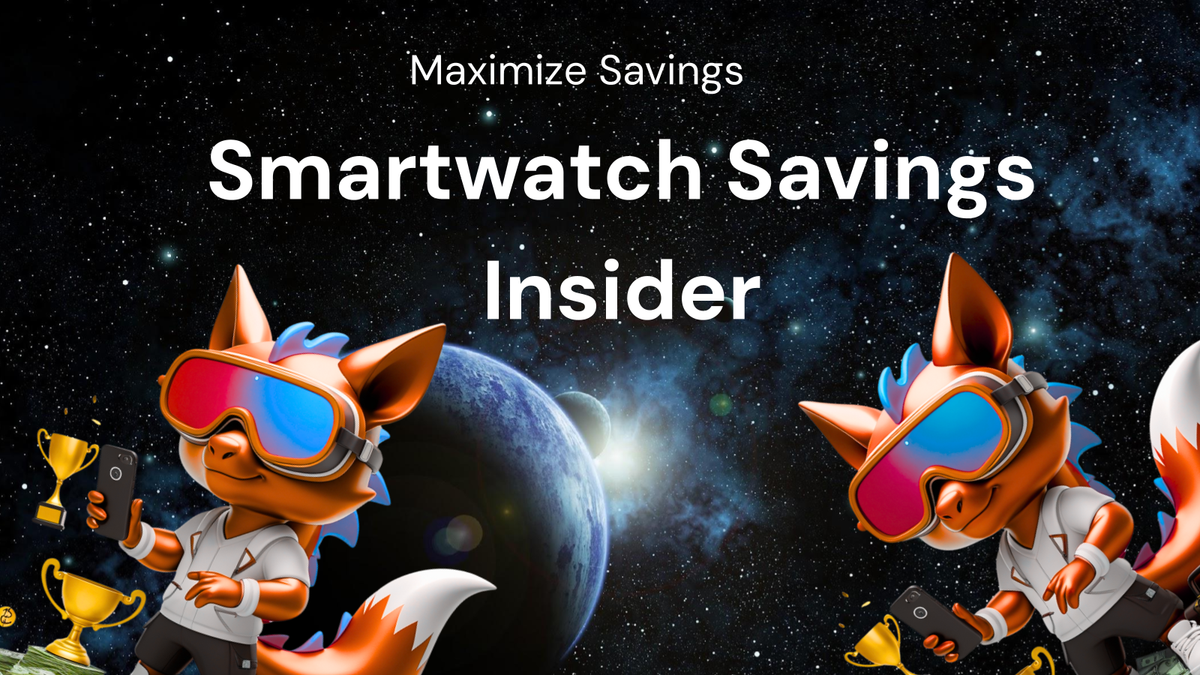Smartwatch Insider Hacks to Maximize Your Savings

Smartwatch Insider Hacks to Maximize Your Savings
Smartwatches have evolved from simple notification centers to powerful extensions of our smartphones, packed with features that can track our fitness, manage our communication, and even control our homes. But beyond the convenience and cool factor, smartwatches also hold the potential to be powerful tools for saving money. You might be surprised to learn that these wrist-worn devices can help you cut down on expenses, make smarter financial decisions, and ultimately boost your overall savings.
This comprehensive guide delves into the world of smartwatch insider hacks, unveiling strategies to maximize your savings potential. We'll explore how to leverage your smartwatch's features to track spending, optimize energy consumption, make informed purchasing decisions, improve your health (and reduce healthcare costs!), and even earn rewards and discounts.
I. Tracking and Analyzing Spending Habits:
One of the most direct ways a smartwatch can help you save money is by fostering greater awareness of your spending habits. Gone are the days of blindly swiping your card and wondering where your money went. Smartwatches, when paired with the right apps and strategies, offer real-time insights into your financial behavior.
- Expense Tracking Apps: Several apps available for both iOS (Apple Watch) and Android (Wear OS) are specifically designed for tracking expenses. Popular options include:
- Mint: A comprehensive personal finance manager that integrates seamlessly with your smartwatch. You can view your budget, track spending across categories, and receive alerts for overspending, all from your wrist.
- YNAB (You Need a Budget): Another popular budgeting app that emphasizes conscious spending. The smartwatch app allows you to quickly log transactions on the go, ensuring your budget is always up-to-date.
- Personal Capital: Focuses on net worth tracking and investment management. The smartwatch app provides a quick overview of your portfolio performance and spending trends.
- Custom Spreadsheets (using IFTTT or similar): For those who prefer a DIY approach, you can leverage IFTTT (If This Then That) to automatically log transactions from your bank account into a Google Sheet. While this requires more initial setup, it offers unparalleled customization.
- How to Use Expense Tracking Effectively:
- Connect Your Accounts: The first step is to link your bank accounts, credit cards, and other financial accounts to the app. This allows the app to automatically track your transactions. Ensure the app uses secure encryption and follows privacy best practices.
- Categorize Your Spending: Accurately categorize each transaction. Most apps provide pre-defined categories like "Groceries," "Dining Out," "Transportation," and "Entertainment." Take the time to create custom categories if needed to reflect your specific spending habits.
- Set Budgets: Establish realistic budgets for each category. Start by analyzing your past spending to get a baseline. Don't be afraid to adjust your budgets as needed.
- Monitor Your Progress: Regularly check your smartwatch to see how you're tracking against your budgets. The visual representations of your spending can be incredibly motivating.
- Identify Problem Areas: Pay attention to categories where you consistently overspend. This will help you identify areas where you can make adjustments to your spending habits.
- The Smartwatch Advantage: The key advantage of using a smartwatch for expense tracking is the accessibility and immediacy. You're more likely to log a purchase immediately after it happens if you can do it with a simple tap on your wrist. This minimizes the risk of forgetting transactions and ensures your data is accurate.
II. Optimizing Energy Consumption:
Energy bills can be a significant expense, but smartwatches can help you take control and reduce your consumption. By connecting to smart home devices and providing insights into your activity levels, your smartwatch can encourage more energy-conscious behavior.
- Smart Home Integration:
- Smart Thermostats (Nest, Ecobee, etc.): Control your home's temperature directly from your smartwatch. Lower the thermostat when you're away or adjust it based on the weather forecast. Many smart thermostats also learn your habits and automatically optimize the temperature for energy savings.
- Smart Lighting (Philips Hue, LIFX, etc.): Turn lights on and off remotely, dim them to reduce energy consumption, and even schedule them to turn off automatically when you leave a room. This eliminates the risk of leaving lights on unnecessarily.
- Smart Plugs: Control appliances and electronics plugged into smart plugs from your smartwatch. Turn off devices that are drawing phantom power, such as TVs, chargers, and coffee makers, when they're not in use.
- Activity Tracking for Energy Awareness:
- Reminders to Move: Smartwatches can remind you to get up and move around after periods of inactivity. Instead of reaching for a snack out of boredom, a movement reminder can encourage you to engage in a more active and healthy alternative, reducing your dependence on comfort food and potentially leading to more efficient energy usage by your body.
- Fitness Tracking for Sustainable Transportation: Tracking your walks, runs, and bike rides can encourage you to choose more sustainable modes of transportation. Walking or biking instead of driving not only saves you money on gas and parking but also reduces your carbon footprint.
- Apps for Energy Monitoring:
- Energy Consumption Dashboards (through Smart Home Integration): Some smart home platforms offer dashboards that display your energy consumption in real-time. You can view this data on your smartwatch to identify areas where you're using the most energy and make adjustments accordingly.
- Dedicated Energy Monitoring Apps: While less common, some apps are specifically designed for tracking energy consumption. These apps may require manual input of your energy bills, but they can help you identify trends and track your progress over time.
III. Making Informed Purchasing Decisions:
Impulse buying can be a major drain on your savings. Smartwatches can help you resist temptation and make more informed purchasing decisions by providing access to information and promoting mindful spending.
- Price Comparison Apps:
- Amazon Shopping: Quickly scan barcodes and compare prices with Amazon's vast database. This ensures you're getting the best deal available.
- Google Shopping: Compare prices from multiple retailers, read reviews, and find the best deals on products you're interested in.
- ShopSavvy: Scan barcodes and compare prices from local and online retailers.
- Note-Taking Apps for Shopping Lists:
- Evernote, Google Keep, Microsoft OneNote: Create and manage shopping lists directly on your smartwatch. This helps you stay focused on what you need and avoid impulse purchases.
- Dedicated Shopping List Apps: Apps like Bring! and Our Groceries offer features specifically designed for shopping lists, such as recipe integration and shared lists.
- Using Reminders and Notifications:
- Wait 24 Hours Rule: Set a reminder to wait 24 hours before making a non-essential purchase. This gives you time to consider whether you really need the item and helps you avoid impulse buys.
- Price Drop Alerts: Set up price drop alerts for items you're interested in. You'll receive a notification when the price drops to your desired level.
- Resisting Temptation with Mindful Spending:
- Use your smartwatch's timer to practice mindful breathing exercises: When you feel the urge to make an impulse purchase, take a few minutes to practice mindful breathing. This can help you calm your emotions and make a more rational decision.
- Review your budget on your smartwatch: Before making a purchase, take a moment to review your budget on your smartwatch. This can help you stay within your limits and avoid overspending.
IV. Improving Health and Reducing Healthcare Costs:
Investing in your health is an investment in your financial future. Smartwatches are powerful tools for tracking your fitness, promoting healthy habits, and potentially reducing your healthcare costs.
- Fitness Tracking and Motivation:
- Activity Tracking: Track your steps, distance, calories burned, and active minutes. Set goals and receive notifications when you reach them. This encourages you to be more active and improve your overall fitness.
- Workout Tracking: Track your workouts, including running, swimming, cycling, and weightlifting. Monitor your heart rate, pace, and other metrics to optimize your performance.
- Challenges and Competitions: Participate in challenges and competitions with friends or other users. This adds a social element to your fitness journey and can provide extra motivation.
- Health Monitoring and Early Detection:
- Heart Rate Monitoring: Monitor your heart rate throughout the day and during workouts. Detect irregular heart rhythms and receive alerts if your heart rate is too high or too low.
- Sleep Tracking: Track your sleep patterns and identify areas where you can improve your sleep quality. Poor sleep can lead to a variety of health problems, including obesity, diabetes, and heart disease.
- Blood Oxygen Monitoring (SpO2): Some smartwatches can measure your blood oxygen levels. Low blood oxygen can be a sign of respiratory problems.
- Fall Detection: Some smartwatches have fall detection features that can automatically call for help if you fall and are unable to get up. This is especially useful for seniors or individuals with mobility issues.
- Apps for Health and Wellness:
- Meditation Apps (Headspace, Calm): Practice mindfulness and reduce stress with guided meditation sessions. Stress can contribute to a variety of health problems.
- Nutrition Tracking Apps (MyFitnessPal): Track your calorie intake and macronutrient ratios. This can help you lose weight, maintain a healthy weight, and improve your overall nutrition.
- Hydration Reminders: Receive reminders to drink water throughout the day. Staying hydrated is essential for good health.
- Reducing Healthcare Costs:
- Preventive Care: By promoting healthy habits and detecting potential health problems early, smartwatches can help you avoid costly medical treatments and hospitalizations.
- Lower Insurance Premiums: Some health insurance companies offer discounts to individuals who use fitness trackers and meet certain activity goals. Check with your insurance provider to see if they offer any such programs.
- Telemedicine Integration: Some smartwatches allow you to connect with doctors and other healthcare providers through telemedicine apps. This can save you time and money compared to in-person visits.
V. Earning Rewards and Discounts:
Beyond saving money directly, some smartwatches and associated apps offer opportunities to earn rewards and discounts, further boosting your savings potential.
- Fitness Rewards Programs:
- Achievement Programs: Some fitness apps offer rewards for achieving certain milestones, such as walking a certain number of steps or completing a certain number of workouts.
- Health Insurance Rewards: Some health insurance companies offer rewards for participating in wellness programs and meeting certain health goals.
- Corporate Wellness Programs: Many companies offer wellness programs that reward employees for engaging in healthy activities.
- Cashback and Rewards Apps:
- Rakuten, Ibotta: Earn cashback on purchases made through these apps. Some of these apps have smartwatch integrations that allow you to activate deals and track your earnings directly from your wrist.
- Credit Card Rewards: Use a credit card that offers rewards for purchases made through your smartwatch.
- Loyalty Programs:
- Store Loyalty Cards: Store your loyalty cards on your smartwatch and easily access them when you're shopping. This ensures you're always taking advantage of available discounts and rewards.
- App-Based Loyalty Programs: Many retailers offer loyalty programs through their apps. You can access these programs on your smartwatch and earn rewards for your purchases.
VI. Conclusion:
Smartwatches are more than just gadgets; they're powerful tools that can help you take control of your finances, improve your health, and ultimately save money. By leveraging the features and strategies outlined in this guide, you can unlock your smartwatch's full potential and start maximizing your savings today. From tracking your spending and optimizing energy consumption to making informed purchasing decisions and earning rewards, your smartwatch can be a valuable partner in your journey to financial well-being. So, explore the apps, experiment with the settings, and discover the insider hacks that work best for you. You might be surprised at how much money you can save simply by being more mindful and informed. The future of saving may very well be on your wrist!




